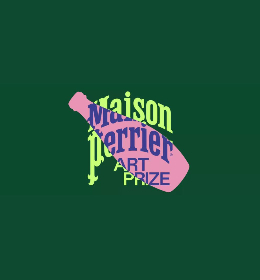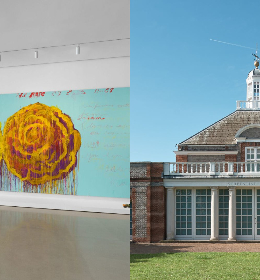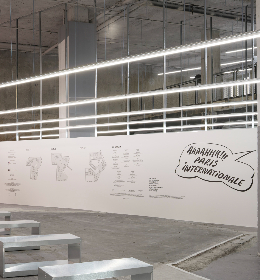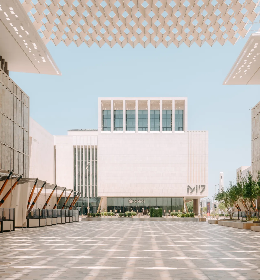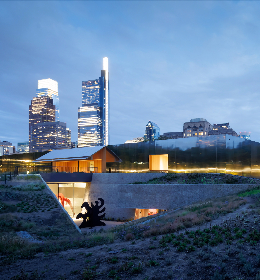A graduate of Pratt Institute with an MFA painting/MA art history, and now a painter and long time professor at Pratt Institute, Brennan is working on a new series inspired by Venice, entitled Mare Internum. The first five paintings in this series have recently been on display along with artists Monique Rollins and Hahn Hyewon in the Campo della Chiesa on the Isola Sant’Elena in Venice, in a show entitled Infinite Jest. The works incorporate the semi-precious stone pigment, lapis lazuli, famous historically as a prized blue found applied to works by Michelangelo such as his Last Judgement and sought after by many artists over the centuries.

photo © Anne Murray
Brennan had received a grant to experiment with the pigment and has since been inspired to create the works for his new series. The title, a Latin phrase meaning “inner sea”, relates to ancient maps of the Mediterranean. Brennan explains this connection: “This term appealed to me because this group is a meditation on water, being surrounded by it, and my own internalization of the lagoon from being in Venice last summer. I had read and objected to something Hal Foster recently wrote citing “the myth of interiority”—I think maybe he borrowed that from Benjamin? This was something I wanted to test, to work against; could I convey this nebulous, yet real, experience via paint?”
A shimmer of silver just beneath the surface of the paintings breaks through in reflections, much like old photographs on metal plates. Other works have a white underpainting; this variance manipulates the viewer, encouraging them to look more closely at the works when passing by them, the underpainting achieving a series of reflections, like water, from different angles on its surface. These paintings also have a luminosity in their blue tones, much like the rich blues of cyanotypes, those wonderful blue photos created through exposing photographic paper to sunlight and developing the image through the one-of-a-kind production of placing objects directly on the surface of the paper. This combination of references to photography is an interesting twist with both silver plate work and the rich blue tones, an impression of that which has been placed on the surface of the work, that which blocks the scene. These paintings become witnesses to something that has been taken away, an internal world of metaphor, enlivened by life near the water. The artist’s palette knife seems to cut up the surface and yet also create a texture that layers this internal light. These paintings have an aura akin to that which is referred to by Walter Benjamin, bringing back a magical quality to the artist’s images. Brennan speaks more directly about these inferred connections to his work: “I’ve been painting for a long time, over 30 years. My older work was aligned with the larger discourse of advanced abstraction. My work is more personal now, although I’m still engaged with tertiary issues about the monochrome and its intermedia context. My painting may be skeletal or reductive, but it alludes to printmaking (monotypes, cyanotypes), photography and film, digital technology and design, and lately the tactility/humility of ceramics. I realize that’s a tall order for a monochrome painting, but I do try to internalize these other qualities. I’m living in the present cultural moment along with everyone else. My work is encrypted, nothing is overt, but that doesn’t mean there’s an absence of content either.”
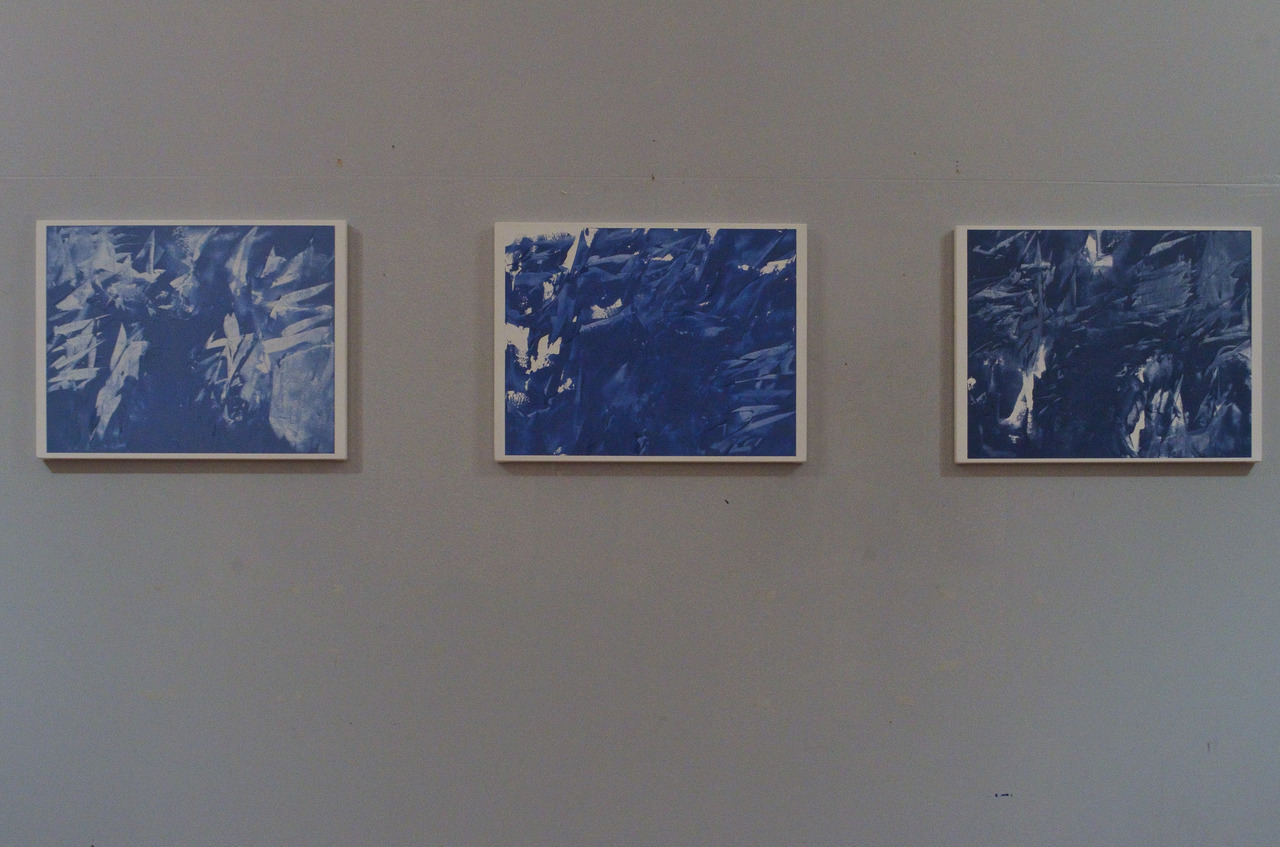
photo © Anne Murray
On the physical qualities of painting, Brennan commented: “I like using traditional pigments, not just for their color, but for their mineral qualities. I think humans respond to these properties innately—the material richness of lapis lazuli, malachite, etc. Many Venetian painters added powdered glass to their painting. It works mostly as a drying agent, but it increases bulk too, which changes the reactive character and luminosity of paint. For me, being a painter is about the activation and transformation of material. Maybe this is a modernist remnant, but I think if someone is trying to do something new in art, they must also do something new with materials—this can be difficult in painting given its considerable history. Even though I’ve been teaching painting at the graduate level for several years, I find myself having different, and perhaps more materials-specific, conversations about painting while working with my colleagues in Venice—there’s maybe more room for that conversation here, rather than in NYC.”
Wondering what specifically interests Brennan in paint as a medium, I enquired about the paint itself:
“I think a lot about the particle size of paint, its tone, how it might react with the knife... Painterly concerns. Yet all of this is secondary to the larger question of what can I find in paint? What is possible, what can be conjured, or conveyed? These concerns drive me,” explains Brennan with fervour.
Living in a rather particular area of Brooklyn, Brennan sees parallels in the environment between his neighbourhood and Venice. “I live and work in Gowanus, Brooklyn, a block away from a network of canals built by the Dutch. The canals are in their post-industrial phase. They’re heavily polluted—legendarily polluted—but they’re slowly being cleaned now. The area is gentrifying and being marketed as “The Venice of Brooklyn.” There was a previous “Venice of Brooklyn,” a real estate development on the backside of Coney Island, complete with gondolas, that failed. The architect Rem Koolhaas wrote about this in Delirious New York. The dream lives on,” he commented.
In discussing this parallel with Brennan, one is reminded of the saturation of experience that is infused into these paintings through a sensitively received environment in connection with the personal and reflective life of the artist. Glimpses of light and shadow, moments of clarity, and understanding, epiphanies dance across the canvas with a light and dark, a peaceful and pivotal combination of mental movement manifested in the rhythm of the palette knife and strokes.
“When I returned to Brooklyn I gave some thought to what it means to live by these canals, as remnants, and to live around a structured waterborne environment generally. What most people don’t realize is that the Gowanus Canal is surprisingly still active, it’s not some entirely dead derelict,” Brennan explains with a clarity and directness which inspires one to visit the Gowanus Canal, an expectation of the light and rhythm of Venice at the back of one’s imaginary mental landscape.
Contemplating the connection between the experience of the artist and that of the scholar and professor in the Venetian environment, I queried whether Brennan’s role as a teacher also plays a part in his work: “I would say that being a professor has a profound effect on my artistic self, sometimes negative, in that as an instructor I’m constantly reaffirming the basics of painting. On the other hand, the constant exchange and challenge that comes with working with younger artists is healthy, mutually beneficial—thinking aloud, thinking on one’s feet, the sharing of material knowledge and discovery, rubbing up against difficult content—what could be more interesting? I love working with young artists on their projects, and I prefer the scholarly model of being an artist. I think that’s an important, less visible, way of being an artist in the world.”
What does Brennan consider important about Venice as an artist and for his own work? “I think the totality of the environment in Venice inspires everyone. You walk into a church, scuola, or palazzo and there are examples of orders of work—Byzantine, Renaissance, Baroque, Modern—existing simultaneously. This is culture across all media and time functioning at a very high level. If we’re just talking about painting alone, the tradition of oil on canvas begins here, the whole painterly playbook of Titian begins here. The intersection of East and West—I could go on. There’s such a great deal for any artist to consider here.”
Next up for Brennan is his solo exhibition at Minus Space, most likely in 2020, before which he hopes to more fully develop the Mare Internum group, as the work included in Infinite Jest was mostly preliminary.





